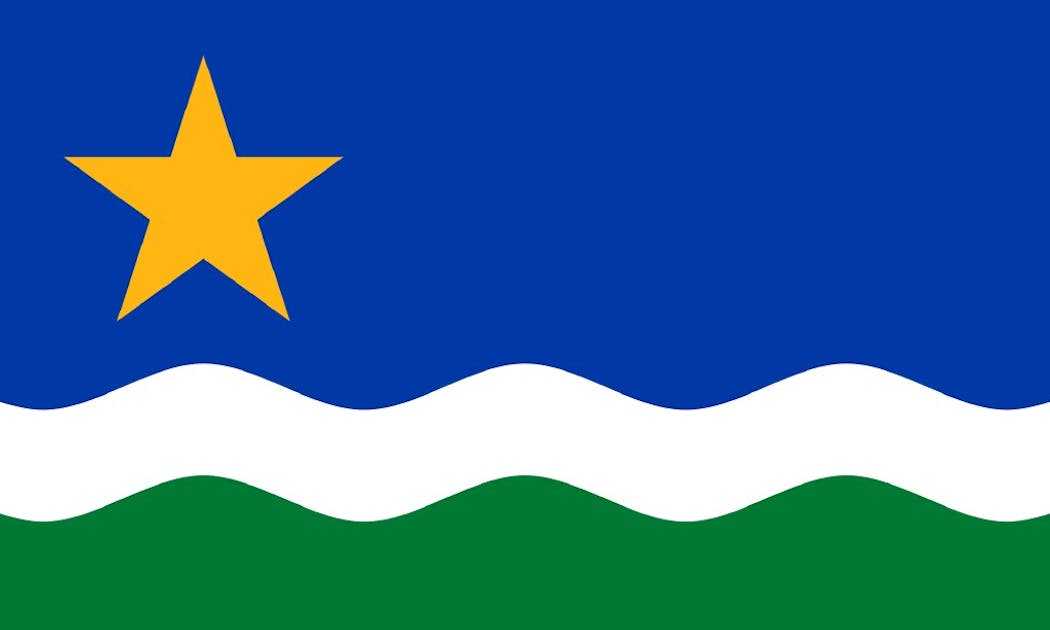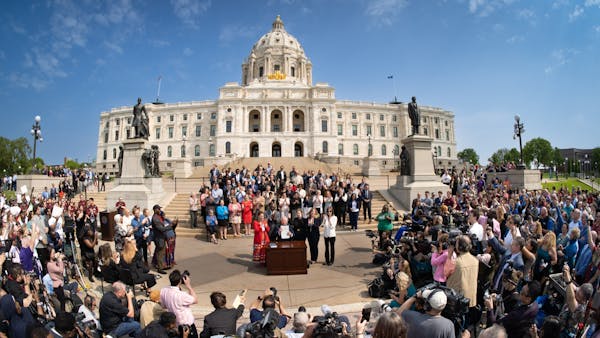Anita Talsma Gaul pulled up a picture of Minnesota's state flag for her history students and asked them to react.
At the center of the flag, a barefoot pioneer plows a field as an American Indian on horseback rides toward the sunset. The students noticed three different dates and 19 stars. There are six lady's slipper flowers, three pine trees, St. Anthony Falls in the distance and a banner waving "L'Etoile du Nord," the state motto.
One student defended the design as part of Minnesota's history. But "a number of them said, 'Yeah, this flag's a mess,' " said Gaul, who teaches state history at Minnesota West Community and Technical College in Worthington.
For Gaul, the discussion was a preview of the issues she'll need to unpack as one of 13 members of the State Emblems Redesign Commission, which is tasked with redesigning a state flag and seal that have largely remained unchanged throughout Minnesota's history.
The commission's first meeting is Tuesday, giving members just four months to come up with new designs by the Jan. 1 deadline — all while grappling with thorny questions about history and representation.
"Given our very short timeframe, I hope we can do a good job," Gaul said. "This is our legacy in a sense to future generations. We need to do this right."
Native American tribes and flag aficionados have been trying to convince lawmakers for years to reconsider the design of the flag, which they've argued is problematic on several levels.
The biggest issue for tribal leaders is the imagery on the state seal, which they protest as historically inaccurate. It depicts the Native man on horseback riding away and appearing to give up the land to a pioneer plowing the field. The seal is featured prominently at the center of the state flag.
"That's a sad part of our history, and it's one that the discussion around this flag has brought up for a lot of Minnesotans," said Sen. Mary Kunesh, DFL-New Brighton, a descendant of the Standing Rock Lakota Tribe who successfully pushed the bill to create the redesign commission last session.
"I've had more positive responses that, yes, that needs to go away and we need to have something that is a symbol of unity across Minnesota," Kunesh said.
Packed with symbolism
The seal was created after statehood in 1858, adapted from a version Minnesota used as a territory. The state didn't have an official flag until 1893, when it came under pressure to have something to fly at the World's Fair in Chicago. The approved design included the state seal embroidered at the center against a white background on the front side and blue on the back.
The design intentionally was packed with symbolism. The pines and lady's slippers represented the state tree and flower, and the 19 stars reflected Minnesota's place as the 19th state admitted to the Union after the original 13 colonies. The three dates on the flag represented the years when Fort Snelling was established (1819), Minnesota became a state (1858) and the flag was created (1893).
The flag's design was simplified in 1957 and given a royal blue backdrop on both sides — the two-color sides made the flag expensive to reproduce — but many details of the original flag remained.
Many others have objected to the flag based purely on its design. The North American Vexillological Association, which studies flags, ranks Minnesota's as among the worst state and provincial flags in the U.S, and Canada. More than a dozen other state flags also use the state seal mounted on a blue background, making Minnesota's unremarkable. The design is crowded and hard to decipher from a distance.
"People come in the store and ask to get a state flag ... I show it to them and they say, 'Oh, so that's what it looks like,' " said Lee Herold, who runs Herold Flags in Rochester and has been advocating for a new state flag for decades.
Instead, his customers often choose a simplified design he helped create that features a golden North Star on the hoist against a backdrop of blue, white and green wavy horizontal stripes — representing the state's water, winter, farmland and forests.
"The real test of a flag and what the commission really needs to consider most is [if it] will resonate with the public?" Herold said. "Will the public like and use it?"
A new design will require approval from seven of the commission's 13 members, who must hold open meetings and seek public comment on the final design. Four additional members of the commission are legislators who can't vote but can participate in the discussions, including Sen. Steve Drazkowski, R-Mazeppa, who said in a statement that he wants a flag that unites the state's citizens.
"I would be disappointed if the commission makes this flag design an opportunity to memorialize political movements or controversial symbols that would only divide the state," he said.
Kim Jackson, a member of the redesign commission appointed by the Council on Asian Pacific Minnesotans, is a graphic designer and art director by trade and describes herself as a flag nerd. She used to draw flags from different countries growing up and couldn't resist the chance to be a part of the commission.
"It's an enormous honor and a dream assignment," said Jackson, who thinks about her two children when she reflects on the work she's about to do. "I call it Minnesota's future history, in hopes that we can come together and create something that is beautiful and they can be proud of."
Gaul can't help but think of the commission's assignment from a historian's perspective. But to her that doesn't mean things can't change.
"It's an offensive flag, and it doesn't represent all of us and it doesn't unite all of us. At the most basic level, that's what we need," she said. "Sometimes, it's time for a reboot."
Former DFL Senate Majority Leader Kari Dziedzic dies of cancer at age 62

How the Star Tribune is covering the 2024 election

Fact check: Walz and Vance made questionable claims during only VP debate

In Tim Walz's home city, opposing groups watch him debate on the national stage



